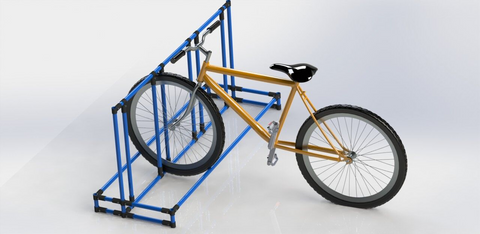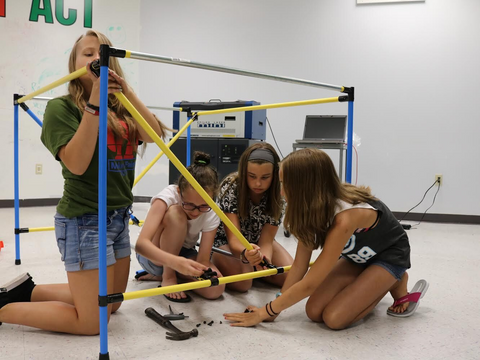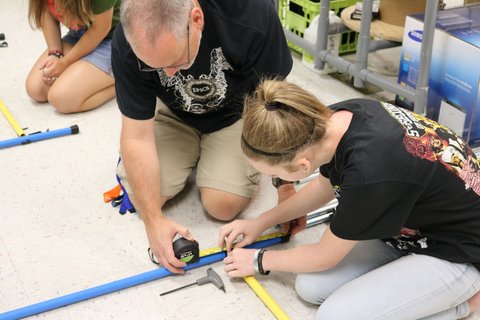Your Cart is Empty
The beginning of a school year can be a brilliant and exciting time for students and teachers alike—or it can be rough. The difference, often, lies in how the first week's tone is set.

But every teacher has the potential to signal that they honor their students' abilities and creativity, and every class has the potential to become a classroom family. The key, often, is in projects that provide a tangible learning experience.
To keep within a public school teacher's budget, we suggest the versatile and affordable solution of a conduit pipe. Its strength and versatility lends itself to the frame and support for a myriad of school projects. And with varied options for the shape and direction of structural pipe fittings and electrical conduit fittings, modular pipe projects are as easy and intuitive to design as a classic building toy, while leaving you room to incorporate more complex curriculum topics.
Here are a few DIY pipe project ideas to welcome your students in for an exciting, hands-on year!

This project is great for a physics, leadership, or even civics class. Engage your students immediately with a project that makes the school environment theirs, and contributes in a positive way to a place they care about.
Constructing a bike rack opens up opportunities for research and engagement with their fellow students, prompting questions such as:
An electrical conduit bike rack alone provides organization for the bikes, but not necessarily security. How do students transform this into a workable option?
Seeking places to store and secure the bike rack, cooperation and approval from the school administration, and then publicity for the rest of the student body all require leadership skills and thought. This project dips into the very practical world of building, and grounds an ordinary STEM assignment in the reality of engineering and construction—helping people and improving their lives.
It also passes the torch: How can your students create a more welcoming space for their student body?

In a home, even very young children should have some space they are allowed to customize. We as educators and parents know that this is good practice to give any human being a sense of agency. It's the reason that each member of a married couple needs to be involved in designing, arranging, and maintaining the home, and why so many find success in having a space that is designated as their own.
Similarly, students should have a classroom that feels like their own. Contributing to your space is one of the quickest ways to build pride in it, both establishing your respect for your students and building their respect and appreciation for you. Create space for their ideas by offering up a physical space for modification.
From there, it's up to the class to brainstorm. Some ideas to get you started...
Whatever the project, it will maintain a lasting touch through your students' year in the classroom, and a reminder of their proud work whenever they walk in.
In real life, often electrical components need to pass through water or areas that may be exposed to water. Electrical conduit, specifically, is used to run wires in places that are wet, underground, or both. Can your class use electrical conduit to provide energy to six LED-lit paper "houses" on two sides of a plastic tub lake? What about wiring the activation switch for a watering system through a classroom window box?

These practical problems show the real-world problems faced by electrical engineers, and wiring through water, outdoor conditions, or underground need only be part of the challenge. These real world elements can be incorporated into projects about creating parallel circuits, measuring amperes, calculating resistance needed, and all sorts of regular curriculum topics while creating something less run-of-the-mill and procedural to complete.
They also lend the work done in your classroom a feeling of relevance and hands-on involvement, setting the tone for a year of student-engagement and hands-on learning.
This one's perfect for a high school or middle school class, especially in collaboration with a history teacher: Have your students ever heard of Samuel Morse?
The challenge in this project is in creating a circuit that can send electrical signals to produce Morse code, or even other message systems. Whether your students encode their messages in sound, in light, in pencil scratches on paper, or even grow a wild hair and find a way to hook up a keyboard, they'll need to learn how to create stable circuits over long distances and the ins and outs of switches.
Thefun is in navigating the maze of the school campus—without making anyone trip. Remember, laying a length of structural pipe flat on the ground in a walkway is against ADA guidelines, but they need to use the pipe to protect the circuit from the elements.
As such, your students will need to get creative with their use of EMT pipe and connectors to make their maze of a circuit reach from point A to point B.
When fostering class connection, there's no harm in healthily teacher-moderated competition: Who can send their message the farthest? (Just make sure no one hoards all the needed pipe fittings or longest lengths of pipe before their classmates can reach them!)

This project requires commitment from you, the teacher. It suggests that your classroom and its structure will be open-ended enough that students will be able touse the classroom reading corner, and that should not just be reserved for the high-achievers or early finishers. After all, if everyone contributed to a space, everyone should be able to access and use it, especially in a compassionate and collaborative classroom.
The materials this build requires diverge notably from our other projects. Gone is the emphasis on electrical components, and in their place come fabric and wooden boards. Look at our inspirations for patio-style chairs and object stands, or have students work in groups and pitch to each other their own designs for seats and a structural pipe bookshelf.
To go a step beyond the ordinary, wiring can be run through your shelving unit to create lighting, or a reading light can be wired directly into a small side table (built with pipe of course!).
Get creative together, then delegate work and build with your hands together, and you'll have a class that's bonded from week one. The physical space they've made, and opportunities to use it throughout the year, will remind them that they can work, finish, and achieve something extraordinary.

Whether you're a music teacher or a science teacher, your students will benefit from the study of waves and harmonics. But the presentation of the project will and should differ:
In a science class, focus on calculating wavelength and lengths of structural pipe to be cut before you begin. Consider providing your students with the wavelength of an A above middle C (tuned differently for different ensembles, but most commonly 440 Hz) and an understanding of whole- and half-steps, and allow them to calculate the wavelengths needed for other notes in the scale. Once the design is complete, the cutting and testing begins. Experiment with end caps on pipes and have students hypothesize on how their use will change the sound. (On nearly all designs, since this functions as a node, the instrument's open tone will change by an octave). Xylophones, vibraphones, and recorders can all be made with cutting tools and/or drills.
In a music class, it's not about the math. In fact, creating an assignment that's too dauntingly math heavy can needlessly isolate some students, or make them feel inadequate in a class where their musical strengths should be allowed to shine through. If you want to take a more math and science grounded approach, then a study of waves will give your students that exposure without the embarrassment.
Study common orchestral instruments and their construction.
Can we rebuild any instruments we know?
Can your class design a new one?
Pull elements from different instruments and see what can be combined. You may find your students putting finger holes on a set of chimes built with EMT, or experimenting with tightening and loosening pipe fittings to change pitch on a recorder mid-song.
Over the past few years, many schools have had the fortunate opportunity to update their available technology. Unfortunately, not all have made that technology available to all students. What better way to welcome your students back to school than by making the school's resources more accessible to them and their peers?
Help your students feel powerful and give them a say on campus with this project. Whether it stays in the library or the computer lab or goes roving from classroom to classroom, a wheeled laptop cart is easier to organize, clean, and simply easier touse. Plus, though a fantastic team building exercise, it's also all but an adapted pipe bookshelf on wheels.
Because this is a simple project, it requires planning in advance to ensure every student has an important role to fill. It's best to let students voice for which roles they would be interested. Some might even bring completely new and unexpected ideas to the table, and have skills or experience you couldn't have predicted.
But to prepare for that first day of class, here are some role ideas to suggest:

Tell any teacher that the key behind any curriculum planning is to provide rich materials within their meager school budget, and they'll laugh: "That's the idea, isn't it?" But creative, larger-than-life building projects don't need to be the stuff of dreams, or take a bite out of your paycheck once the school and PTA's budget is sapped.
The beauty of owning one diverse set of connectors suited to any 3/4 inch electric conduit or other electrical conduit pipe is that one year or month's project can be disassembled to make another entirely new.
In fact, the reuse of your pipe building materials could be a great lesson in green living.
Currently, most of the electrical conduit waste ends up in a landfill. However, landfills do not solve the disposal dilemma. Recycling and reuse, however, brings with it some very real benefits.
Recycling your pipe building materials helps reduce the amount of new pipe material manufactured. Recycling uses less than half the energy required to process the original pipe material and emits only 10 percent of the greenhouse gases.
Hence, it results in significantly lower contribution to global warming.
These are other facts in which you can build your lesson plan around:
We're excited to work with your school. For more inspiration or to ask any questions about which of our products are best to spark your students' minds, reach out to our customer service team and we'll help you find the best-fit projects and products for your students and you.